What is Biochromography?
Chromography means the study of colour. Colour on paper can be visualized by the naked eye with the help of inks. Therefore, biochromography implies the synthesis or sourcing of these chromogenic components through biological sources.
Need for Biochromography?
Commercial ink is made of carbon alongwith a host of synthetic dyes, pigments, and other chemicals. If swallowed, these chemicals can result in a wide variety of health hazards. 1
The International Agency for Research on Cancer has classified Carbon Black as a carcinogen. Toner ink cartridges produce carbon monoxide upon overheating, which can result in nausea, dizziness, and even death. 2 Solvents and chemical components present in synthetic ink can lead to skin irritation and dermatitis upon skin contact. p-Anisidine which is used for development of shine in synthetic inks has been observed to cause headaches and nerve damage. 3
Besides the above-mentioned health hazards, synthetic ink also leads to a wide variety of environmental hazards due to the presence of chemical components such as heavy metals, volatile compounds, petroleum oils, etc. 4
All these factors have resulted in the need to develop ink sourced from biological components, which are regarded to be biologically safe and ecologically friendly. As per US Government guidelines, federal agencies have to use ink containing 10-40% vegetable oil for printing purposes. The oils used are soybean, linseed, canola, sunflower, castor, etc. 5
This ink is known as ‘vegetable oil ink’ which contains vegetable oil content equal to or above the standard content level. 6

Types
Chromogenic components synthesized from biological sources can be classified as per the source of the pigment produced.
- Phytochromography â€" Plants used as a source of chromogenic components can be regarded as phytochromography. 7 Plants are an abundant source of pigments which can be isolated and processed for chromogenic purposes.
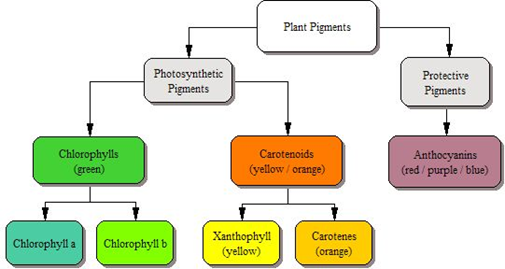
Before synthetic ink came to be used, plants were regarded as chromogenic sources for dyeing of fabric as well as printing paper. Vegetable dyes were used on a large-scale in the pre-industrial times. However, the discovery of an aniline dye sourced from coal tar led to an increased usage of synthetic dyes. This resulted in a virtual dead-end as far as the usage of plant-based pigments was concerned. 9
As mentioned above, the consequences of using synthetic dyes are extremely severe from the perspectives of health as well as the environment. As such, history has itself set a precedent as far as the usage of plant-sourced chromogenic components is concerned. 9
Colour extraction from plants takes place using the following steps – 9
1. Soaking or boiling the plant source in water so as to release the colour – Some plant sources release the colour merely upon physical contact, whereas others require exposure to higher temperatures. The extreme temperature breaks down the cellular structure of the plant cell, releasing its chromogenic components. 9
2. Separation of the chromogenic components – Usage of non-toxic “modifiers” such as potash alum, baking soda, etc. so as to “release” the various hues present in the chemically complex chromogenic components by differentiating the primary chromogen into various constituents. For instance, berries of Solanum scabrum have been found to release as many as eight distinct hues upon the usage of sodium carbonate as a modifier. 9
3. Preparation of aqueous extract inks – Dissolving plant material in specified quantity of water with the addition of modifiers, and heating this mixture to boiling point. The concentration of the colour obtained can be adjusted by adjusting the boiling period. 9
Ink Garden – In European countries, plants are cultivated in nurseries as crops which can be used for synthesizing ink. 9
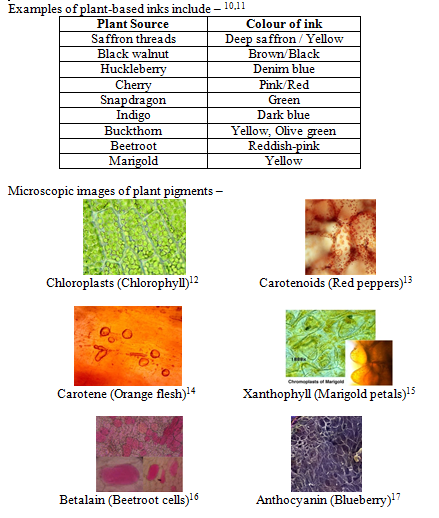
- Zoochromography â€" Release of ink by animals is known as zoochromography. This release of ink is carried out as a defence mechanism by cephalopods such as squids, octopuses, and cuttlefishes. 18

Chemical composition of cephalopod ink is as follows â€" 24
1. Melanin â€" Contributes to dark colour of ink
2. Enzymes â€" Involved in the Melanin-Forming pathway.
♦ Tyrosinases â€" Act on Tyrosine to form Dopachrome
♦ Dopachrome Rearranging Enzymes â€" Catalyze formation of Eumelanin
♦ Peroxidases â€" Associated with Melanosomes and form Eumelanin
♦ Catecholamines â€" Intermediary substrates found in cephalopod ink
3. Peptidoglycans â€" Obtained from ink fragmented and degraded by enzymes. These are mainly branched glucosamine glycans. These peptidoglycans are studied for their anti-predatory properties, contributing to defence functioning of ink secretion.
4. Amino Acids â€" Rich in free amino acids, specifically Taurine, Glutamate, and Tyrosine. Also involved in defence functioning.
5. Metals â€" Cadmium, Copper, Lead found to be present. Possibly involved as enzyme modulators in melanin pathway.
6. Toxins â€" Presence of symbiotic bacteria results in the formation of Tetrodotoxin (TTX) in Hapalochlaena lunulata which does not have anti-venom (lethal to humans). Domoic acid, a toxin transferred via algae in the food chain was found in organs of Octopus vulgaris.
The Cochineal insect secretes Carminic acid which can be used to produce crimson-coloured ink. 25
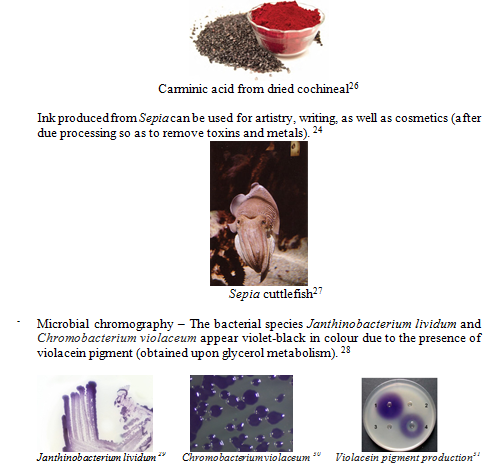
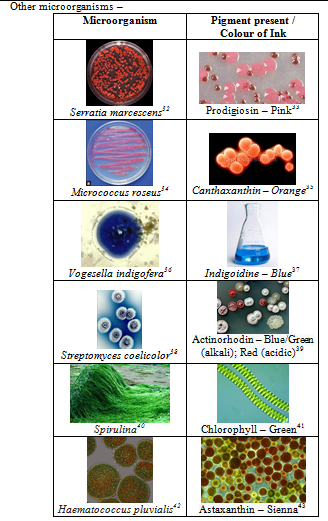
- Inks for Bioprinting
In the process of bioprinting, the "ink" used for printing a three-dimensional body part/tissue is made of live cells embedded within water-based layers (Hydrogel). These cells also possess the same kind of pigments which are needed in order to obtain an entire tissue/organ possessing the physical appearance and texture identical to the original body part. 44
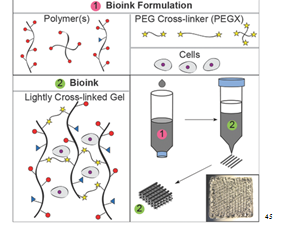
Conclusion
Inks produced from synthetic sources have an adverse impact on the health and environment. There are alternatives available such as inks derived from plants, animals as well as micro-organisms. It is hoped that these bio-inks result in durability as well as viability so as to withstand the toughest of environmental conditions, such as light and water resistance.
References
1. Ink â€" Wikipedia, The Free Encyclopedia. Available from https://en.wikipedia.org/wiki/Ink#Health_and_environmental_aspects (Accessed on May 19, 2016)
2. Sherber C. What Are the Dangers of Toner Ink Exposure? | Chron.com. Available from http://smallbusiness.chron.com/dangers-toner-ink-exposure-55298.html (Accessed on May 19, 2016)
3. Ink. Available from https://www.tititudorancea.net/z/ink.htm (Accessed on May 19, 2016)
4. Inks â€" The Sustainable Designers Quick Guide. Available from http://sustainable-graphic-design.blogspot.in/2011/08/inks-sustainable-designers-quick-guide.html (Accessed on May 19, 2016)
5. Harlan J. There Are Vegetables in That Ink! â€" Live Green â€" Recyclebank. Available from https://livegreen.recyclebank.com/there-are-vegetables-in-that-ink (Accessed on May 19, 2016)
6. EINS Corporation/Vegetable Oil Ink. Available from http://www.shiga-web.or.jp/eins-en/print/kank-vegetable.html (Accessed on May 19, 2016)
7. MUDAM: Herbarium: Phytochromography. Available from http://www.mudam.lu/en/agenda/details/event/herbarium-phytochromography/ (Accessed on May 19, 2016)
8. Mr. Mohn’s Biology Home Turf | Fall Colors And Photosynthesis. Available from http://www5.bluevalleyk12.org/mohn/fall-colors-and-photosynthesis/ (Accessed on May 19, 2016)
9. Shaw P. Phytochromography: Screen Printing with Plants: Research into Alternative Ink Technology. Leonardo. 1999;32(1):33-39. Retrieved from http://www.jstor.org/stable/1576623 (Accessed on May 19, 2016)
10. Huckleberry Ink | The Druid’s Garden. Available from https://druidgarden.wordpress.com/tag/huckleberry-ink/ (Accessed on May 19, 2016)
11. Buckthorn berries â€" CAMEO. Available from http://cameo.mfa.org/wiki/Buckthorn_berries (Accessed on May 19, 2016)
12. General Botany | Introduction. Available from http://emp.byui.edu/wellerg/The%20Cell%20Lab/Eukaryotic%20Cells/The%20Eukaryotic%20Cell%2002%20Cell.html (Accessed on May 19, 2016)
13. Carotenoids â€" Red Pepper. Available from http://metabolism.net/bidlack/botany/botanypics/plant%20cells/Carotenoids-Red%20Pepper.jpg (Accessed on May 19, 2016)
14. Saturday Science Sessions | Under My Microscope. Available from https://thepanekroom.com/2015/07/19/saturday-science-sessions-under-my-microscope/ (Accessed on May 19, 2016)
15. Image: Marigold composite. Available from http://botit.botany.wisc.edu/Resources/Botany/Plant%20Cell/Plastids/Chromoplasts/Petal%20Tissue/Marigold%20Petal%20Tissue/Marigold%20composite%20MC%20.jpg.html (Accessed on May 19, 2016)
16. Lab 2 â€" Experimental Design. Available from http://hirrel.com/biol1440/SciMethod/SciMet_beet.htm (Accessed on May 19, 2016)
17. Food Under The Microscope: Blueberry. Available from http://i.telegraph.co.uk/multimedia/archive/02477/blueberry_2477392k.jpg (Accessed on May 19, 2016)
18. Inking by Cephalopods â€" National Zoo. Available from https://nationalzoo.si.edu/Animals/Invertebrates/Facts/cephalopods/inking.cfm (Accessed on May 19, 2016)
19. Squid Ink Is Prehistorically Perfect. Available from https://photosciencechanel.com/2012/05/22/squid-ink-is-prehistorically-perfect/ (Accessed on May 19, 2016)
20. Octopus Defence Mechanisms. Available from https://acccearthscience.wikispaces.com/Octopus+Defense+Mechanisms+-+CB (Accessed on May 19, 2016)
21. Cuttlefish. Available from http://www.nthsweb.net/pietas/labs/lab04/lab04.html (Accessed on May 20, 2016)
22. Cephalopod Ink â€" Wikipedia, The Free Encyclopedia. Available from https://en.wikipedia.org/wiki/Cephalopod_ink#Protective_mechanisms (Accessed on May 20, 2016)
23. Dissected Arrow Squid. Available from http://squid.tepapa.govt.nz/images/gallery/anatomy/article-04/image-10.jpg (Accessed on May 20, 2016)
24. Derby CD. Cephalopod Ink: Production, Chemistry, Functions and Applications. Marine Drugs. 2014;12(5):2700-2730. doi:10.3390/md12052700
25. Flinn A. Natural Colours â€" Carmine & Cochineal. Available from http://gentleworld.org/natural-colors-carmine-cochineal/ (Accessed on May 20, 2016)
26. Carmine / Cochineal | DDW The Color house. Available from http://www.ddwcolor.com/natural-colours/carminic-acid-carmine-cochineal/ (Accessed on May 20, 2016)
27. Sepia (genus) â€" Wikipedia, The Free Encyclopedia. Available from https://en.wikipedia.org/wiki/Sepia_(genus) (Accessed on May 21, 2016)
28. Fang M-Y, Zhang C, Yang S, et al. High crude violacein production from glucose by Escherichia coli engineered with interactive control of tryptophan pathway and violacein biosynthetic pathway. Microbial Cell Factories. 2015;14:8. doi:10.1186/s12934-015-0192-x
29. Janthinobacterium lividum â€" PetShop.Bio. Available from https://www.petshop.bio/products/janthinobacterium-lividum (Accessed on May 21, 2016)
30. Chromobacterium violaceum. Available from http://www.atcc.org/~/media/Attachments/E/9/F/E/31532_colony.ashx (Accessed on May 21, 2016)
31. Chen C-N, Chen C-J, Liao C-T, Lee C-Y. A probable aculeacin A acylase from the Ralstonia solanacearum GMI1000 is N-acyl-homoserine lactone acylase with quorum-quenching activity. BMC Microbiology. 2009;9:89. doi:10.1186/1471-2180-9-89
32. Serratia marcescens Bacteria. Available from http://edenprairieweblogs.org/scottneal/post/1338/ (Accessed on May 21, 2016)
33. Shanks R. Learning How Bacteria Causes Infections. Available from http://www.foxcenter.pitt.edu/research/learning-how-bacteria-causes-infections (Accessed on May 21, 2016)
34. Mohana DC, Thippeswamy S, Abhishek RU. Antioxidant, antibacterial, and ultraviolet-protective properties of carotenoids isolated from Micrococcus spp. Radiat Prot Environ. 2013;36:168-74. doi:10.4103/0972-0464.142394
35. Micrococcus roseus bacterium. Available from http://images.sciencesource.com/preview/BA4279.html (Accessed on May 21, 2016)
36. Vogesella indigofera | Exploring the Invisible. Available from https://exploringtheinvisible.com/2012/11/27/sustainable-denim-microbial-indigo/vog6/ (Accessed on May 21, 2016)
37. Indigoidine. Available from http://www.eurekalert.org/multimedia/pub/109598.php?from=319887 (Accessed on May 21, 2016)
38. Streptomyces coelicolor â€" MicrobeWiki. Available from https://microbewiki.kenyon.edu/index.php/Streptomyces_coelicolor (Accessed on May 21, 2016)
39. Streptomyces coelicolor. Available from http://mml.sjtu.edu.cn/laotuo/Compressed%20for%20Carton%20CHEN/3/PICT7338%20Streptomyces%20coelicolor%20bldA.jpg (Accessed on May 21, 2016)
40. Spirulina. Available from http://www.tijelojehram.com/chlorella-spirulina/ (Accessed on May 21, 2016)
41. What is Spirulina? Remedies. Available from http://remedies.ie/spirulina/2284/ (Accessed on May 21, 2016)
42. Haematococcus pluvialis Extract. Available from http://www.ec21.com/product-details/Astaxanthin-1.5-Microalga-Haematococcus-Pluvialis--5640455.html (Accessed on May 21, 2016)
43. Haematococcus. Available from http://cmapspublic2.ihmc.us/rid=1M9RZ7PKL-22NQRFW-2RS/haematococcus.jpg (Accessed on May 21, 2016)
44. Bioprinting Process | Organovo. Available from http://organovo.com/science-technology/bioprinting-process/ (Accessed on May 21, 2016)
45. Engineering Materials to 3-D Print Tissues and Organs. Available from http://news.feinberg.northwestern.edu/2015/06/engineering-materials-to-3-d-print-tissues-and-organs/ (Accessed on May 21, 2016)
About Author / Additional Info:
I am a post-graduate in Biochemistry from the University of Mumbai